The Pentagon
| The Pentagon | |
|---|---|
| Arlington County, Virginia | |
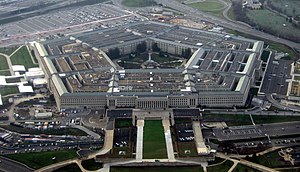 The Pentagon, pictured here in January 2008. | |
| Coordinates | 38°52′15.56″N 77°3′21.46″W / 38.8709889°N 77.0559611°W |
| Type | Headquarters |
| Height | Five floors above ground and two floors below the ground |
| Site information | |
| Owner | United States Department of Defense |
| Controlled by | U.S. Secretary of Defense |
| Condition | In Service |
| Site history | |
| Built | September 11, 1941 – January 15, 1943 |
| Built by | John McShain, Inc. |
| In use | 1943–present |
The Pentagon is the headquarters of the United States Department of Defense, located in Arlington County, Virginia. As a symbol of the U.S. military, "the Pentagon" is often used metonymically to refer to the Department of Defense rather than the building itself.
Designed by the American architect George Bergstrom (1876–1955), and built by Philadelphia, Pennsylvania, general contractor John McShain, the building was dedicated on January 15, 1943, after ground was broken for construction on September 11, 1941. General Brehon Somervell provided the major motive power behind the project;[1] Colonel Leslie Groves was responsible for overseeing the project for the Army.
The Pentagon is the world's largest office building by floor area, with about 6,500,000 sq ft (600,000 m2), of which 3,700,000 sq ft (340,000 m2) are used as offices.[2][3] Approximately 23,000 military and civilian employees[3] and about 3,000 non-defense support personnel work in the Pentagon. It has five sides, five floors above ground, two basement levels, and five ring corridors per floor with a total of 17.5 mi (28.2 km)[3] of corridors. The Pentagon includes a five-acre (20,000 m2) central plaza, which is shaped like a pentagon and informally known as "ground zero", a nickname originating during the Cold War and based on the presumption that the Soviet Union would target one or more nuclear missiles at this central location in the outbreak of a nuclear war.[4]
On September 11, 2001, exactly 60 years after the building's groundbreaking, hijacked American Airlines Flight 77- a Boeing 757-223 was crashed into the western side of the Pentagon, killing 189 people, that were five hijackers, 59 others aboard the plane, and 125 working in the building.[5]
History
Construction

The United States Department of War was headquartered in the Greggory Building, a temporary structure erected during World War I along Constitution Avenue on the National Mall. The War Department, which was a civilian agency created to administer the U.S. Army, was spread out in additional temporary buildings on National Mall, as well as dozens of other buildings in Washington, D.C., Maryland and Virginia. In the late 1930s a new War Department Building was constructed at 21st and C Streets in Foggy Bottom but, upon completion, the new building did not solve the department's space problem and ended up being used by the Department of State.[6] When World War II broke out in Europe, the War Department rapidly expanded with anticipation of being drawn into the conflict. Secretary of War Henry L. Stimson found the situation unacceptable, with the Munitions Building overcrowded and the department spread out.[7][8]
Stimson told President Franklin D. Roosevelt in May 1941 that the War Department needed additional space. On July 17, 1941, a congressional hearing took place, organized by Virginia congressman Clifton Woodrum, regarding proposals for new War Department buildings. Woodrum pressed Brigadier General Eugene Reybold, who was representing the War Department at the hearing, for an "overall solution" to the department's "space problem" rather than building yet more temporary buildings. Reybold agreed to report back to the congressman within five days. The War Department called upon its construction chief, General Brehon Somervell, to come up with a plan.[9]
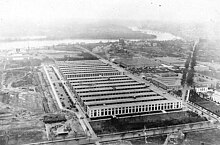
Government officials agreed that the War Department building should be constructed across the Potomac River, in Arlington, Virginia. Requirements for the new building were that it be no more than four stories tall, and that it use a minimal amount of steel. The requirements meant that, instead of rising vertically, the building would be sprawling over a large area. Possible sites for the building included Arlington Farm, adjacent to Arlington National Cemetery, and the obsolete Washington Hoover Airport site.[10]
The site originally chosen was Arlington Farms which had a roughly pentagonal shape, so the building was planned accordingly as an irregular pentagon.[11] Concerned that the new building could obstruct the view of Washington, D.C. from Arlington Cemetery, President Roosevelt ended up selecting the Hoover Airport site instead.[12] The building retained its pentagonal layout because a major redesign at that stage would have been costly, and Roosevelt liked the design. Freed of the constraints of the asymmetric Arlington Farms site, it was modified into a regular pentagon.[13][14]
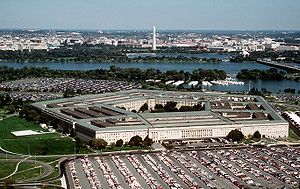
On July 28 Congress authorized funding for a new Department of War building in Arlington, which would house the entire department under one roof,[15] and President Roosevelt officially approved of the Hoover Airport site on September 2.[16] While the project went through the approval process in late July 1941, Somervell selected the contractors, including John McShain, Inc. of Philadelphia, which had built Washington National Airport in Arlington, the Jefferson Memorial in Washington, and the National Naval Medical Center in Bethesda, Maryland, along with Wise Contracting Company, Inc. and Doyle and Russell, both from Virginia.[17] In addition to the Hoover Airport site and other government-owned land, construction of the Pentagon required an additional 287 acres (1.16 km2), which were acquired at a cost of $2.2 million.[18] The Hell's Bottom neighborhood, a slum with numerous pawnshops, factories, approximately 150 homes, and other buildings around Columbia Pike, was also cleared to make way for the Pentagon.[19] Later 300 acres (1.2 km2) of land were transferred to Arlington National Cemetery and to Fort Myer, leaving 280 acres (1.1 km2) for the Pentagon.[18]
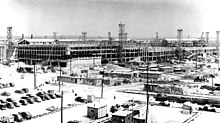
Contracts totaling $31,100,000 were finalized with McShain and the other contractors on September 11, and ground was broken for the Pentagon the same day.[20] Among the design requirements, Somervell required the structural design to accommodate floor loads of up to 150 pounds per square inch, which was done in case the building became a records storage facility at some time after the end of the current war.[16] A minimal amount of steel was used as it was in short supply during World War II. Instead, the Pentagon was built as a reinforced concrete structure, using 680,000 tons of sand dredged from the Potomac River, and a lagoon was created beneath the Pentagon's river entrance.[21] To minimize steel, concrete ramps were built rather than installing elevators.[22][23] Indiana limestone was used for the building's facade.[24]
Architectural and structural design work for the Pentagon proceeded simultaneously with construction, with initial drawings provided in early October 1941, and most of the design work completed by June 1, 1942. At times the construction work got ahead of the design, with different materials used than specified in the plans. Pressure to speed up design and construction intensified after the attack on Pearl Harbor on December 7, 1941, with Somervell demanding that 1,000,000 sq ft (9.3 ha) of space at the Pentagon be available for occupation by April 1, 1942.[25] David J. Witmer replaced Bergstrom as chief architect on April 11 after Bergstorm resigned due to charges, unrelated to the Pentagon project, of improper conduct while he was president of the American Institute of Architects.[26]
Construction of the Pentagon was done during segregation in the United States. This had structural consequences to the design of the building. Under the supervision of colonel Leslie R. Groves, the decision to have separate eating and lavatory accommodations for whites and blacks was made and carried out. The dining areas for blacks were put in the basement and on each floor there were double toilet facilities separated by gender and race. These measures of segregation were said to have been done in compliance with the state of Virginia’s racial laws. The Pentagon as a result has double the standard amount of toilet facilities that would be needed for a building of its size.[27][28]
President Roosevelt had made an order ending such racial discrimination in the U.S. military in June 1941. When the President visited the Pentagon before its dedication he questioned Groves regarding the number of washrooms and ordered him to remove the “Whites Only” signs. The Pentagon for a long time was the only building in Virginia where segregation was not allowed.[28]
The soil conditions of the Pentagon site, located on the Potomac River floodplain, presented challenges to engineers, as did the varying elevations across the site, which ranged from 10–40 ft (3.0–12.2 m) above sea level. Two retaining walls were built to compensate for the elevation variations, and cast-in-place (Franki) piles were used to deal with the soil conditions.[29] Construction of the Pentagon was completed in approximately 16 months at a total cost of $83 million. The building is 77 feet (23 m) tall, and each of the five sides of the building is 921 feet (281 m) long.[30]
Protests
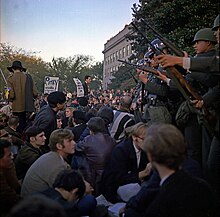
The Pentagon became a spot for protests against the Vietnam War during the late 1960s. A group of 2,500 women, organized by Women Strike for Peace, demonstrated outside of Secretary of Defense Robert S. McNamara's office at the Pentagon on February 15, 1967.[31] In May 1967, a group of 20 demonstrators held a sit-in outside the Joint Chiefs of Staff's office, which lasted four days before they were arrested.[32] In one of the better known incidents, on October 21, 1967, some 35,000 anti-war protesters organized by the National Mobilization Committee to End the War in Vietnam, gathered for a demonstration at the Defense Department (the "March on the Pentagon"), where they were confronted by some 2,500 armed soldiers. During the protest, a famous picture was taken, where George Harris placed carnations into the soldiers' gun barrels.[33] On May 19, 1972, the American radicals known as the Weather Underground Organization successfully planted and detonated a bomb in a fourth-floor women's restroom in the Pentagon. They announced it was in retaliation for the Nixon administration's bombing attacks on Hanoi during the final stages of the Vietnam War.[34]
On March 17, 2007, 4,000 to 15,000 people (estimates vary significantly) protested against the Iraq War.[35] The protesters marched from the Lincoln Memorial, down Washington Boulevard to the Pentagon’s north parking lot.
Renovation
From 1998 to 2011, the Pentagon underwent a major renovation, known as the Pentagon Renovation Program. This program, completed in June, 2011, involved the complete gutting and reconstruction of the entire building in phases to bring the building up to modern standards, removing asbestos, improving security, providing greater efficiency for Pentagon tenants, and sealing of all office windows.[36]
As originally built, most Pentagon office space consisted of open bays which spanned an entire ring. These offices used cross-ventilation from operable windows instead of air conditioning for cooling. Gradually, bays were subdivided into private offices with many using window air conditioning units. With renovations now complete, the new space includes a return to open office bays, a new Universal Space Plan of standardized office furniture and partitions developed by Studios Architecture.[37]
September 11 attacks

On September 11, 2001, The Pentagon's 60th birthday, a team of five al-Qaeda affiliated hijackers took control of American Airlines Flight 77, en route from Washington Dulles International Airport to Los Angeles International Airport, and deliberately crashed into the Western side of the Pentagon at 9:37 am EDT as part of the September 11 attacks. All 64 people on the airliner were killed as were 125 people who were in the building. The impact of the plane severely damaged the structure of the building and caused its partial collapse.[39] At the time of the attacks, the Pentagon was under renovation and several offices were unoccupied, resulting in fewer casualties. Only 800 of 4,500 people who would have been in the area were there because of the work. Furthermore the area hit, on the side of the Heliport Entrance facade, was the section best prepared for such an attack. The renovation there, improvements which resulted from the Oklahoma City bombing, had nearly been completed.[40][41][42]
It was the only area of the Pentagon with a sprinkler system, and it had been reconstructed with a web of steel columns and bars to withstand bomb blasts. The steel reinforcement, bolted together to form a continuous structure through all of the Pentagon's five floors, kept that section of the building from collapsing for 30 minutes—enough time for hundreds of people to crawl out to safety. The area struck by the plane also had blast-resistant windows—2 inches thick and 2,500 pounds each—that stayed intact during the crash and fire. It had fire doors that opened automatically and newly built exits that allowed people to get out.[40]
Contractors already involved with the renovation were given the added task of rebuilding the sections damaged in the attacks. This additional project was named the "Phoenix Project", and was charged with having the outermost offices of the damaged section occupied by September 11, 2002.[43][44][45]
When the damaged section of the Pentagon was rebuilt, a small indoor memorial and chapel were included, located at the point of impact. For the fifth anniversary of the September 11, 2001 attacks, a memorial of 184 beams of light shone up from the center courtyard of the Pentagon, one light for each victim of the attack. In addition, an American flag is hung each year on the side of the Pentagon damaged in the attacks, and the side of the building is illuminated at night with blue lights. After the attacks, plans were developed for an outdoor memorial, with construction underway in 2006. The Pentagon Memorial, which consists of a 2 acres (8,100 m2) park with 184 benches, according to the victims' ages, from 3 to 71, was opened to the public on September 11, 2008.[46][47][48]
Shootings
On March 4, 2010 at 6:40 pm, two police officers working for the Pentagon Force Protection Agency were shot near an entrance to the Pentagon and fired back with their pistols at the suspect. The officers were slightly injured but were treated in a hospital and released. The suspect, identified as John Patrick Bedell (aged 36) died at the hospital. No clear motive was established.[49]
On October 19, 2010 shortly before 5 am, an unidentified gunman shot at the south side of the building, shattering, but not penetrating windows on the third and fourth floors. The offices behind those windows were vacant due to renovations. The Pentagon Reservation was locked down as authorities swept the area for evidence, and the building was reopened about 5:40 am. The Joint Terrorism Task Force is leading the investigation into the incident.[50]
Earthquake
On August 23, 2011, a 5.8 magnitude earthquake in Mineral, Virginia shook the Pentagon.[51] The building suffered minor damage, with flooding from broken pipes.
Layout

The Pentagon building spans 28.7 acres (116,000 m2), and includes an additional 5.1 acres (21,000 m2) as a central courtyard.[52] It has five façades, listed starting with the north side and moving clockwise: the Mall Terrace Entrance façade, the River Terrace Entrance façade, the Concourse Entrance (or Metro Station) façade, the South Parking Entrance façade, and the Heliport façade.[42] On the north side of the building, the Mall Entrance, which also features a portico, leads out to a 600 ft (180 m) long terrace that is used for ceremonies. The River Entrance, which features a portico projecting out 20 ft (6.1 m), is located on the northeast side, overlooking the lagoon and facing Washington. A stepped terrace on the River Entrance leads down to the lagoon; and a landing dock was used until the late 1960s to ferry personnel between the Bolling Air Force Base and the Pentagon.[52] The main entrance for visitors is located on the southeast side, where the Pentagon Metro station and the bus station are located. There is also a concourse on the southeast side of the second floor of the building, which contains a mini-shopping mall. The Pentagon's south parking lot is located on the southwest side of the Pentagon, and the west side of the Pentagon faces Washington Boulevard. The building contains no marble because Italy, which was the main source of marble during World War II, was an enemy country to the US[53] until September 1943, several months after completion.

The concentric rings are designated from the center out as "A" through "E" (with in addition "F" and "G" in the basement). "E" Ring offices are the only ones with outside views and are generally occupied by senior officials. Office numbers go clockwise around each of the rings, and have two parts: a nearest-corridor number (1 to 10) followed by a bay number (00 to 99), so office numbers range from 100 to 1099. These corridors radiate out from the central courtyard, with corridor 1 beginning with the Concourse's south end. Each numbered radial corridor intersects with the corresponding numbered group of offices (for example, corridor 5 divides the 500 series office block). There are a number of historical displays in the building, particularly in the "A" and "E" rings.
Floors in The Pentagon are lettered "B" for Basement and "M" for Mezzanine, both of which are below ground level. The concourse is located on the second floor at the metro entrance. Above ground floors are numbered 1 to 5. Room numbers are given as the floor, concentric ring, and office number (which is in turn the nearest corridor number followed by the bay number). Thus, office 2B315 is on the second floor, B ring, and nearest to corridor 3 (between corridors 2 and 3). One way to get to this office would be to go to the second floor, get to the A (innermost) ring, go to and take corridor 3, and then turn left on ring B to get to bay 15.[54]
A person can walk between any two points in less than seven minutes.[55]
Just south of the Pentagon are Pentagon City and Crystal City, extensive shopping and high-density residential districts in Arlington. Arlington National Cemetery is to the north. The Washington Metro Pentagon station is also located at the Pentagon, on the Blue and Yellow Lines. The Pentagon is surrounded by the complex Pentagon road network.[56]
The United States Postal Service has established six ZIP Codes for The Pentagon, to which the place name “Washington, D.C.” is assigned, even though The Pentagon is actually located in Virginia.[57]
Security
The Pentagon Force Protection Agency (PFPA) is a United States government agency comprising both sworn federal police officers, the United States Pentagon Police and civilian CBRN technicians, and non-sworn civilian anti-terrorism investigative and physical security personnel, and is responsible for the protection of the Pentagon. The Department of Defense created the PFPA after the September 11, 2001 attacks. The new agency absorbed the Defense Protective Service (DPS) and assumed its role of providing basic law enforcement and security for the Pentagon and Department of Defense sites in the 280 acre (1.1 km2) "Pentagon Reservation" and greater National Capital Region (NCR). PFPA was also charged with providing force protection against the full spectrum of potential threats through robust prevention, preparedness, detection, and response measures. The United States Pentagon Police is the primary federal law enforcement arm of the Pentagon Force Protection Agency.
Services
The Pentagon has over 20 of its own fast food operations, including Subway, McDonald's, Dunkin' Donuts, Panda Express, Starbucks, Sbarro, among others.[58] A multibranded KFC, Pizza Hut, and Taco Bell restaurant opened in 2003, when renovations to the food court were completed.[59] Food services are managed by the Navy Exchange. The Center Courtyard Cafe reopened in the spring of 2008,[60] replacing the "Ground Zero Cafe" snack bar that was previously there.
The Pentagon Athletic Center (PAC), a fitness center for military and civilian staff, opened in 2004[61] adjacent to the north side of the Pentagon, replacing the Pentagon Officers Athletic Club (POAC) which had operated for 55 years in a structure between Route 110 and the parade grounds. Each year, the Pentagon grounds are a major focus for hosting the Marine Corps Marathon and the Army Ten-Miler running events.
There is a Meditation and Prayer Room in the Pentagon, which was dedicated on December 14, 1970, by Secretary of Defense Melvin Laird.[62]
In conjunction with the 1976 American Bicentennial,[63] the Pentagon began offering guided tours to the general public. Tours were suspended after the September 11, 2001 attacks, but are currently available on a pre-arranged basis to the general public.[64]
Other uses
The Pentagon and its parking lots are used as a staging area for a number of large events, including the Army Ten-Miler, the Marine Corps Marathon and Rolling Thunder motorcycle ride. During the Bush Administration, the Department of Defense with the active involvement of Vice President Dick Cheney and Secretary Donald Rumsfeld organized "America Supports Your Freedom Walk" rallies at the Pentagon to show support for the military in Afghanistan and Iraq.[65]
The roads of the Pentagon Reservation are routinely used daily by thousands of commuters between Arlington, Virginia and Washington, DC.
See also
Notes
- ^ Steve Vogel, The Pentagon: a History (2003).
- ^ "The Pentagon – George Bergstrom – Great Buildings Online". Greatbuildings.com. Retrieved October 26, 2008.
- ^ a b c The Pentagon, Facts & Figures (accessed January 19, 2008)
- ^ "Pentagon Hot Dog Stand, Cold War Legend, to be Torn Down". United States Department of Defense. September 20, 2006. Retrieved May 6, 2010.
'It's rumored that a portion of their (Soviet) nuclear arsenal was directed at that building, the Pentagon hot dog stand,' tour guides tell visitors as they pass the stand. 'This is where the building earned the nickname Cafe Ground Zero, the deadliest hot dog stand in the world.'
- ^ DefenseLink.mil – Pentagon Memorial Dedication (accessed May 27, 2009)
- ^ Goldberg (1992), p. 6–9
- ^ "Intro – Secretaries of War and Secretaries of the Army". United States Army Center of Military History. 1992.
{{cite web}}: Unknown parameter|=ignored (help) - ^ "Main Navy & Munitions Buildings". Naval History & Heritage Command. Retrieved October 17, 2008.
- ^ Vogel (2007), pp. 29–33
- ^ Vogel (2007), pp. 35–37
- ^ Bureau of Public Roads memorandum, October 25, 1960.
- ^ "General Information". Retrieved December 4, 2005.
- ^ Vogel, Steve (May 27, 2007). "How the Pentagon Got Its Shape". Washington Post. pp. W16. Retrieved May 26, 2007.
- ^ Roig-Franzia, Manuel (May 13, 2010). "Hemp fans look toward Lyster Dewey's past, and the Pentagon, for higher ground". The Washington Post. Retrieved May 25, 2010.
- ^ Goldberg (1992), p. 22
- ^ a b Goldberg (1992), p. 33
- ^ Goldberg (1992), p. 29
- ^ a b Goldberg (1992), p. 34
- ^ Vogel (2007), p. 131
- ^ Goldberg (1992), p. 35; p. 44
- ^ "Rare, Unseen: Building the Pentagon". LIFE.com.
- ^ McGrath, Amanda (May 26, 2007). "How The Pentagon Got Its Shape (Gallery)". The Washington Post.
- ^ Goldberg (1992), p. 52–53
- ^ Owens, Jim (2005). "Replacing the stone and rebuilding the Pentagon". Mining Engineering. 57 (2): 21–26.
{{cite journal}}: Unknown parameter|month=ignored (help) - ^ Goldberg (1992), p. 39–42
- ^ Goldberg, p. 36
- ^ Robert R. Weyeneth, The Architecture of Racial Segregation: The Challenges of Preserving the Problematical Past,(2005)p.28-30/
- ^ a b Carroll, James. House of war: the Pentagon and the disastrous rise of American power. Boston: Houghton Mifflin Co., 2006. Print. p.4-5
- ^ Goldberg (1992), p. 47; p. 52
- ^ http://pentagon.osd.mil/facts-area.html
- ^ White, Jean M. (February 16, 1967). "2500 Women Storm Pentagon Over War". Washington Post.
- ^ Auerbach, Stuart (May 13, 1967). "Pentagon Protesters Jailed". Washington Post.
- ^ "Flowers, Guns and an Iconic Snapshot". The Washington Post. March 18, 2007. Retrieved May 25, 2010.
- ^ Jacobs, Ron (1997). The Way the Wind Blew. Verso. p. 142. ISBN 1859841678.
- ^ "8 Years After Start of War, Anger Reigns", Washington Post, March 17, 2007 page A1
- ^ Vogel, Steve (June 22, 2011). "New Pentagon Is A Paragon". Washington Post. p. 1.
- ^ Renovation of the Pentagon. Retrieved October 9, 2006.
- ^ "Flight 77, Video 2". Judicial Watch.
- ^ Isikoff, Michael; Daniel Klaidman (June 10, 2002). "The Hijackers We Let Escape". Newsweek. Retrieved Oct. 22, 2009.
{{cite news}}: Check date values in:|accessdate=(help) - ^ a b Schrader, Esther (September 16, 2001). "Pentagon, a Vulnerable Building, Was Hit in Least Vulnerable Spot". Los Angeles Times. Retrieved Feb. 25, 2010.
{{cite news}}: Check date values in:|accessdate=(help) - ^ "Pentagon Renovation: Renovation Program Had Hardened the Facade Attacked on 9/11/01". 9-11 Research. Retrieved February 25, 2010.
- ^ a b "The Pentagon". globalsecurity.org. Retrieved February 25, 2010.
- ^ "Pentagon Renovation Program". Archived from the original on May 8, 2006. Retrieved December 4, 2005.
- ^ Childs, Nick (August 15, 2002). "Americas: Pentagon staff reclaim destroyed offices". BBC News. Retrieved December 4, 2005.
- ^ "Pentagon History – September 11, 2001". Pentagon.osd.mil. Retrieved October 26, 2008.
- ^ Pentagon Memorial Web site
- ^ Official press release at the United States Department of Defense
- ^ Wilgoren, Debbie (September 11, 2008). "Pentagon Memorial Dedicated on 7th Anniversary of Attacks". The Washington Post. The Washington Post Company. Retrieved September 11, 2008.
{{cite news}}: Unknown parameter|coauthors=ignored (|author=suggested) (help) - ^ Klein, Allison (March 5, 2010). "at Pentagon entrance leaves 2 police officers hurt, lone gunman dead". The Washington Post. p. A1.
{{cite news}}: Unknown parameter|coauthors=ignored (|author=suggested) (help) - ^ "Gunman sought in Pentagon shooting". Washington Post. October 20, 2010. p. B1.
{{cite news}}: Unknown parameter|authors=ignored (help) - ^ Fox News article - Magnitude 5.9 Earthquake Hits Virginia, Sends Shockwaves Throughout East Coast (accessed August 23, 2011)
- ^ a b Goldberg (1992), p. 57
- ^ Vogel, Steve, "The Building That Runs Rings Around The Wiliest Generals", Washington Post, February 18, 2009, p. 11.
- ^ "How to Find a Room in the Pentagon". Headquarters, Dept. of the Army. Retrieved September 13, 2007.
- ^ "Man shoots 2 officers outside Pentagon". CNN. March 5, 2010. Retrieved May 25, 2010.
- ^ "Mixing Bowl Interchange Complex". roadstothefuture.com. Retrieved November 22, 2006.
- ^ Facts & Figures: Zip Codes
- ^ "Concessions – The Pentagon". Office of the Assistant Secretary of Defense for Public Affairs. Retrieved March 30, 2008.
- ^ "Pentagon Gets New KFC/Pizza Hut/Taco Bell Multibranded Restaurant". AllBusiness. August 13, 2003.
- ^ "Center Courtyard Cafe" (PDF). Pentagon Renovator Newsletter. February 2008.
- ^ Pentagon Renovation Program[dead link]
- ^ Pentagon Meditation and Prayer Room—website of the Pentagon Meditation Club:
- ^ Stewart, Stephen (April 18, 1982). "Penetrating the Pentagon". The New York Times. pp. Section 10, page 39.
{{cite news}}: More than one of|author=and|last=specified (help) - ^ "The Pentagon Tour Request". August 8, 2008.
- ^ Neuman, Johanna (September 11, 2005). "Pentagon's 'Freedom Walk' Is a March Along America's Divide". Los Angeles Times. Retrieved October 20, 2010.
References
- Goldberg, Alfred (1992). The Pentagon: The First Fifty Years. Office of the Secretary of Defense / Government Printing Office. ISBN 0160379792.
- Vogel, Steve (2007). The Pentagon – A History: The Untold Story of the Wartime Race to Build the Pentagon and to Restore it Sixty Years Later. Random House. ISBN 0812973259.
- Carroll, James (2007). House of War: The Pentagon and the Disastrous Rise of American Power. Mariner Books. ISBN 0618187804.
External links
- The Pentagon website
- Popular Mechanics, March 1943, "Army's Giant Five-by-Five" one of earliest World War Two articles on the Pentagon
- Pentagon Force Protection Agency
- Pentagon Renovation Program
- The Worldwide Network of US Military Bases
- Navigating the Pentagon
- The Pentagon: Relocation Information and The Pentagon Q&A
- Great Buildings Online – The Pentagon
- How the Pentagon Got Its Shape – The Washington Post, May 26, 2007
- A House Divided: Pentagon Trivia Fact retrieved June 13, 2008.
- Satellite image from Mapygon
- The Construction of The Pentagon - Somervell's Folly



